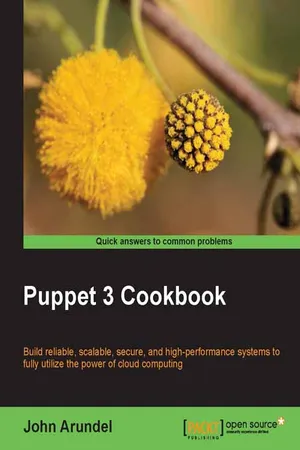
- 274 pages
- English
- ePUB (mobile friendly)
- Available on iOS & Android
Puppet 3 Cookbook
About This Book
In Detail
A revolution is happening in web operations. Configuration management tools can build servers in seconds, and automate your entire network. Tools like Puppet are essential to taking full advantage of the power of cloud computing, and building reliable, scalable, secure, high-performance systems. More and more systems administration and IT jobs require some knowledge of configuration management, and specifically Puppet.
"Puppet 3 Cookbook" takes you beyond the basics to explore the full power of Puppet, showing you in detail how to tackle a variety of real-world problems and applications. At every step it shows you exactly what commands you need to type, and includes full code samples for every recipe.
The book takes the reader from a basic knowledge of Puppet to a complete and expert understanding of Puppets latest and most advanced features, community best practices, writing great manifests, scaling and performance, and extending Puppet by adding your own providers and resources. It starts with guidance on how to set up and expand your Puppet infrastructure, then progresses through detailed information on the language and features, external tools, reporting, monitoring, and troubleshooting, and concludes with many specific recipes for managing popular applications.
The book includes real examples from production systems and techniques that are in use in some of the worlds largest Puppet installations, including a distributed Puppet architecture based on the Git version control system. It covers common problems and errors and shows you how to troubleshoot your Puppet manifests. Youll be introduced to powerful tools that work with Puppet such as Hiera and MCollective. Youll learn how to use objection orientation and classes to write powerful, reusable manifests, and how to embed Ruby code in templates. Youll find out how to extend Puppet with custom resource types and providers. The book also explains managing Rails applications and databases, building web servers, load balancers, high-availability systems with Heartbeat, and many other state-of-the-art techniques.
Approach
"Puppet 3 Cookbook" is written in a Cookbook style, showing you how to set up and expand your Puppet infrastructure. It not only gives you everything you need to become a Puppet expert, but includes powerful code samples and techniques developed over many years of production experience. With it, youll save time and effort by automating tedious manual processes, impress your boss by delivering better business value from IT, and future-proof your career by getting to grips with the new technologies revolutionizing the industry.
Who this book is for
"Puppet 3 Cookbook" is for anyone who builds and administers servers, especially in a web operations context. It requires some experience of Linux systems administration, including familiarity with the command line, file system, and text editing. No programming experience is required.
Frequently asked questions
Information
Puppet 3 Cookbook
Table of Contents
Table of contents
- Puppet 3 Cookbook